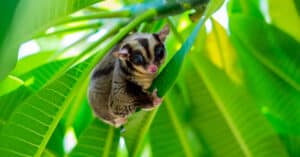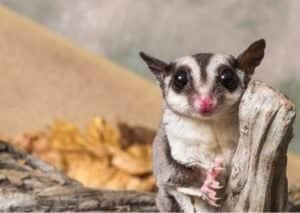
Sugar gliders are cute marsupials with wide round eyes, short bodies, and bushy tails. Although these creatures are sometimes confused for flying squirrels due to their similar behaviors and looks, they are classified as separate species. A flying squirrel is a placental animal, which means that its offspring are born within the uterus of its mother.
A sugar glider, on the other hand, is a marsupial. Marsupials are pouched mammals, which means their young are raised in pouches. Sugar gliders are genetically closer connected to kangaroos rather than flying squirrels.
Curious to learn more about this fascinating animal? Read on to find out all about the sugar glider’s lifespan as well as their average life cycle.
Let’s take a look at all of the fantastic facts about sugar gliders and how they make great pets!
The Rundown On Sugar Gliders
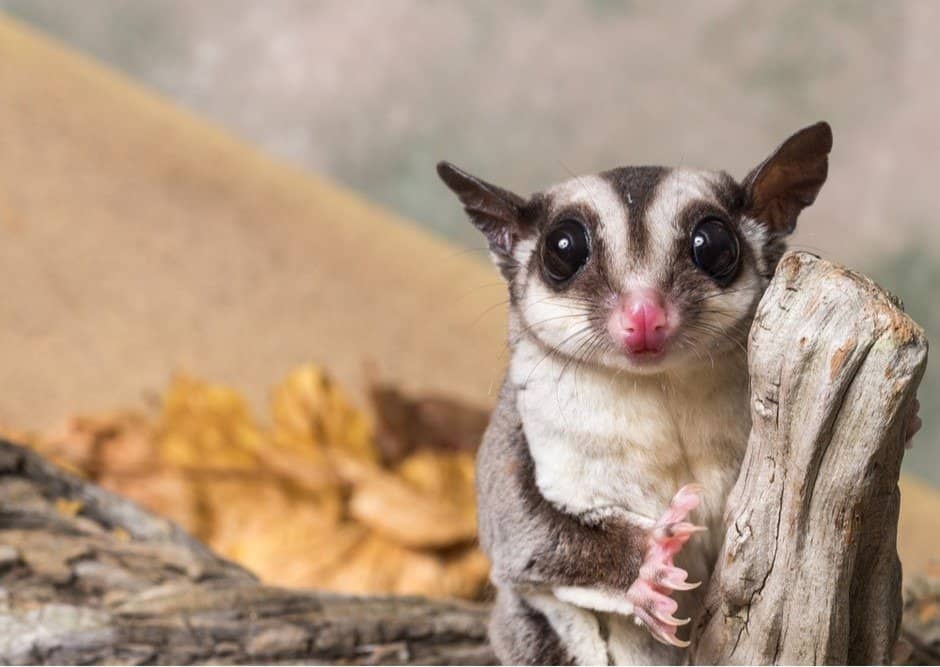
These marsupials are able to glide up to 148.5 ft.
©LesPalenik/Shutterstock.com
Sugar gliders are native to Australia, Tasmania, and other islands. They can be found in rainforests, gliding from tree to tree and inhabiting their hollows. The term “Sugar Glider” comes from their fondness for sweet meals such as fruits and nectar, as well as their remarkable gliding abilities!
Sugar gliders are around 5-6 inches long, with their long bushy tails adding another 6 inches. They also weigh about 4-5 ounces. The patagium is the flexible flap of skin located between a sugar glider’s front and hind legs. Technically, sugar gliders do not “fly” in the way that we think. The Patagium is responsible for the sugar glider’s ability to soar over 50 meters from tree to tree! Consider it a parachute that allows them to navigate and land safely each time.
Sugar gliders are also known for their large eyes. Because these marsupials are nocturnal, their huge eyes are spaced widely apart to assist them in landing and launching from trees at night.
Sugar gliders are unlawful to own in several places, including California, Pennsylvania, Alaska, and a few others. This is due to the fact that they are deemed exotic species in some parts of the United States. Before you buy one, make sure you do your homework to find out if they are legal in your area.
How Long Do Sugar Gliders Live?
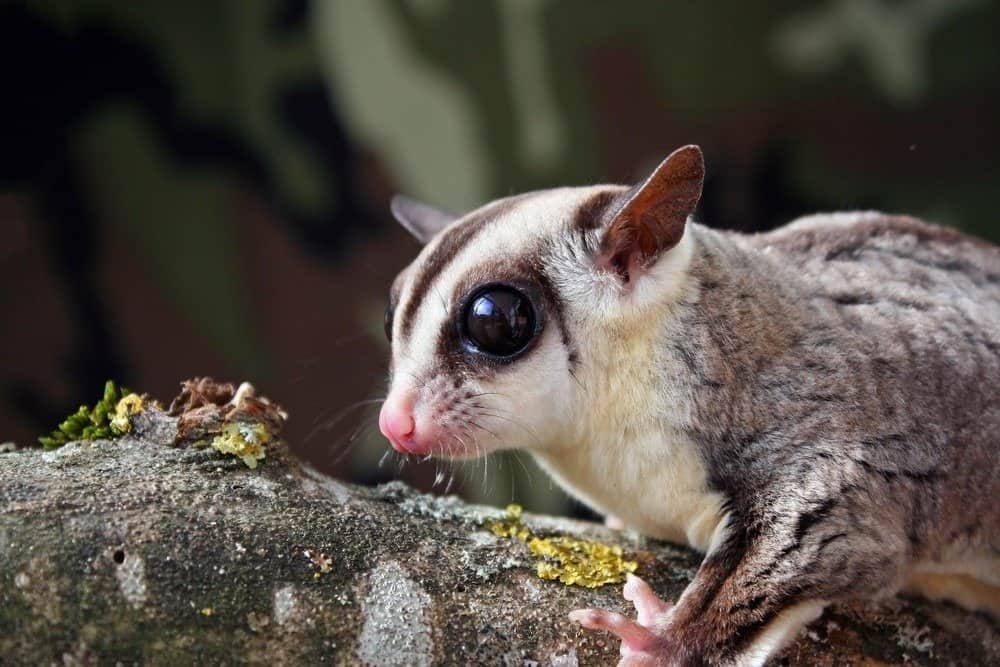
In the wild, sugar gliders can live up to 9 years.
©Fercast/Shutterstock.com
The average sugar glider lifespan is 3 to 9 years in the wild. Sugar gliders tend to live longer in captivity, anything from 10 to 15 years. The oldest reported sugar glider lived to be 17.8 years old.
In the wild, because young sugar gliders cannot thermoregulate until they are 100 days old, biparental care helps to extend the young sugar gliders’ life. This allows one adult to curl up with the young and prevent hypothermia while the other parent is out searching for food.
Nutrition, environment, and health are all important factors in extending their life in captivity.
The Average Sugar Glider Life Cycle
The life cycle of a sugar glider is incredibly fascinating. Let’s explore in detail how this marsupial becomes an adult.
Birth
Female sugar gliders can have one to three litters each year and normally have one or two youngsters. Joeys are the name given to these little newborns. The childbirth process is extremely rapid, lasting only approximately 5 minutes on average. Before giving birth, the female sugar glider will begin licking a trail from her cloaca to her pouch.
They do this so that the fur matted down and their kids don’t become tangled in it by mistake. When the joeys are born, they emerge from the cloaca, approximately the size of a grain of rice, and enter their mother’s pouch. Sugar gliders remain in their mother’s pouches for about 6 weeks.
In Pouch
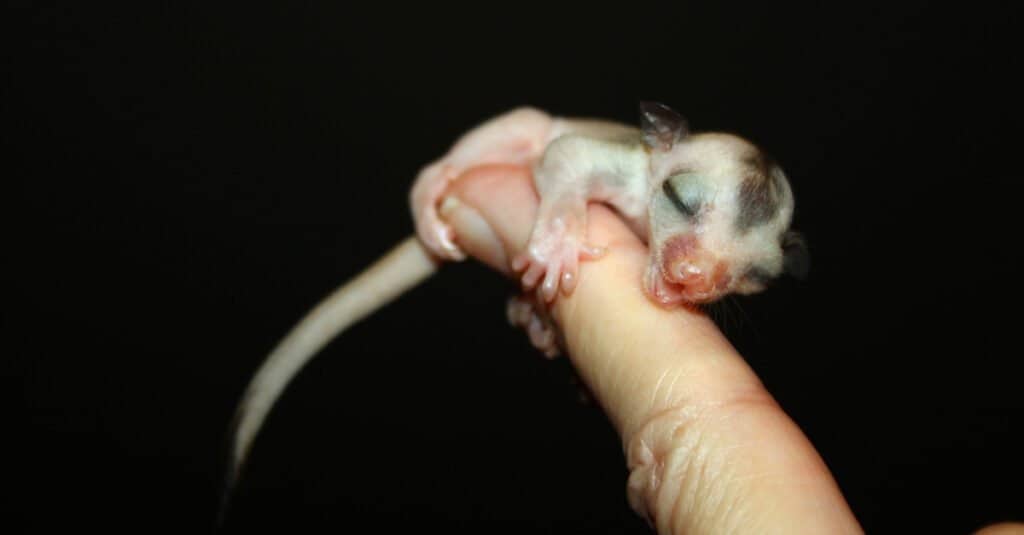
Baby sugar gliders depend on their mothers.
©Doty911/Shutterstock.com
The joey will remain in the pouch for the first six weeks. This is an extremely important stage in the sugar glider’s life cycle. Their mouths will remain clamped onto their mothers’ breasts for the next few weeks. If their jaw is withdrawn from the breast too soon, their life will be on the line. The reason for this is that they are still too young and immature to open and reopen their jaws to latch back on.
Adult
Joeys will begin to cling to their parents’ backs once they have grown too large to fit within their mothers’ pouch. Once they have been pushed out of the pouch, the joey will grow more explorative. They will only leave their parents to eat the food they’ve acquired. However, they still rely heavily on their mother’s milk. When the joey is 8-10 weeks old and outside of the pouch, they will have successfully weaned off their mom’s milk and will be considered independent adults.
Now that we’ve covered all there is to know about the life cycle of a sugar glider, let’s talk about keeping one as a pet.
How to Extend the Life of Your Sugar Glider
Here are the best tips to extend your sugar glider’s life:
- Healthy Diet: A healthy diet is essential for the longevity of a sugar glider. A sugar glider’s diet should consist of 75 percent fruits and vegetables and 25 percent protein. Apples, bananas, carrots, and a variety of other fruits and vegetables are excellent for a balanced diet. Hard-boiled eggs, unseasoned chicken and turkey, as well as tofu, offer all of the protein they require. Sugar gliders also like goodies from time to time as well! Live insects, like crickets and mealworms, are excellent treats for your sugar glider. Just keep in mind that they are heavy in fat and should not be served during every meal.
- Proper Enclosure: It is critical to provide them with a suitable enclosure. A sugar glider cage should be as spacious as possible and as tall as possible to allow them to climb. Make sure the enclosure is maintained in a quiet part of your home throughout the day. Since these little fellas are nocturnal they require lots of rest during the day.
The photo featured at the top of this post is © Manop Boonpeng/Shutterstock.com
Thank you for reading! Have some feedback for us? Contact the AZ Animals editorial team.



